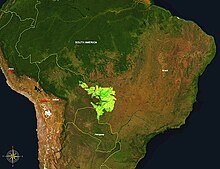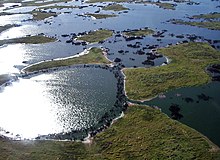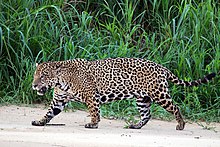Pantanal
The South American Pantanal (from pântano, Portuguese for swamp ) is one of the largest inland - wetlands of the earth. Although the species-rich wetlands is put under protection since 2000 and the World Heritage by UNESCO was declared, it is acutely threatened by industrialization and deforestation.
geography
location
The Pantanal is located in the central southwest of Brazil in the states of Mato Grosso and Mato Grosso do Sul as well as the Mato Grosso Plateau - small parts of the Pantanal still extend to the east of the neighboring states Paraguay and Bolivia to the west .
definition
The Pantanal is a still very little developed and hardly inhabited river lowland with numerous freshwater lakes (also called isolated salt lakes - Salinas in the south ), which is fed by numerous rivers and traversed by the Río Paraguay , the main river that feeds and drains the area. A species-rich wetland has developed there.
size
With an area of around 230,000 km², the Pantanal is almost as large as the Federal Republic of Germany before reunification. It is on average just 95 m above sea level .
places
The Pantanal can be reached from the south via the cities of Aquidauana , Miranda and Corumbá ; from the north via Barão de Melgaço , Cáceres , Poconé and Puerto Suárez .
Transpantaneira
The well-known Transpantaneira, a heaped road that leads 145 kilometers into the Pantanal, also begins in Poconé. It contains 127 large and small wooden bridges, which are often in an adventurous condition and have to be repaired regularly. 1973 began with the construction of a north-south connection, which should extend to the BR-262. However, the project was only implemented in the state of Mato Grosso. The continuous dirt road, which has to be repaired every year and re-paved in many places, ends at the border with the state of Mato Grosso do Sul near Porto Jofre .
Floodplain
The Río Paraguay only has a gradient of 30 meters on its 600 km long path through the Pantanal plain. This is why the water that flows into the basin via numerous rivers due to the precipitation in the northern highlands can only very slowly leave the area again towards the south. Once a year, during the rainy season from November to March, large parts of the lowlands are flooded and two-thirds of the area are sometimes meters deep under water. The result is a complex system of savannahs, huge flooded water areas, rainforest-like river gallery forests and dry forests, as well as a mosaic of rivers, lakes and shallow lagoons, the extent and size of which are determined by the annual cycle of rainy and dry seasons. During the rainy season, the cattle - but also the wild animals - retreat to the dry forests and to the embankments of the rivers, each of which was created by sediment deposits .
Flora and fauna

In this unique habitat there are an estimated 665 bird species more than in all of Europe; among ornithologists is also believed that not all are discovered. The Pantanal has the largest abundance of hyacinth macaws in Brazil and it has become a very important refuge for the critically endangered giant otter . The approximately 123 species of mammals include predators such as the jaguar , puma and ocelot and their prey such as marsh deer , peccaries and capybaras , the largest rodents in the world that can weigh up to 70 kilograms. There are also at least 2000 species of plants, 269 species of fish, countless reptiles and amphibians and a multitude of insects. The bird Jabiru , the giant stork, is the symbol of the Pantanal. Caimans populate this area with 35 million specimens.
When the Paraguay River floods the Pantanal from October to March, large parts of the wetland are covered with giant Victoria water lilies.
Fish fauna
A large number of fish species live in the rivers, lagoons and flood plains of the Pantanal, the life cycle of which is determined by the rainy and dry seasons. The dominant species include large predatory fish such as dourados ( Salminus maxillosus ), traíras , tucunaré peacock bass ( Cichla temensis ) and smaller ones such as peacock eye bass ( Astronotus ocellatus ). In the shallower and sandy areas there are freshwater ray species such as B. Potamotrygon falkneri . Schooling fish such as the lambari rue tetra ( Astyanax bimaculatus ), piraputangas ( Brycon microlepis and Brycon hilarii ) and Pacús ( Piaractus mesopotamicus ) are also popular. Piranhas such as Natterer's saw tetra ( Pygocentrus nattereri ), black- banded saw tetra ( Serrasalmus spilopleura ) and Serrasalmus marginatus play an important role in carrion removal . In addition, you meet there catfish species as Zungarowelse (Jau, Paulicea luetkeni ) Pintados ( Pseudoplatystoma corruscans ) and porthole-shovel catfish (Jurupoca Hemisorubim platyrhynchus ) to.
natural reserve
Part of the area is under nature protection; the Otuquis National Park in Bolivia in the border triangle Brazil-Bolivia-Paraguay with 9034 km², the Pantanal Matogrossense National Park in Brazil with 1350 km² and the Río Negro National Park in Paraguay with 1238 km² are the three largest protected areas. You acceded to the Ramsar Convention in 2001, 1993 and 1995, respectively . In 2000, UNESCO named the Pantanal Matogrossense National Park and three adjacent private protected areas of the Brazilian environmental protection organization Ecotrópica (total area 1878 km²) a World Heritage Site . In the same year, the entire Pantanal within Brazil was declared a biosphere reserve. The Global Nature Fund and Ecotropica have named the Pantanal “ Endangered Lake of the Year 2007”.
threat
The skins of the Jacarés , a crocodile subfamily , bring a lot of money on the black market , including rare fish and birds as well as parrots and the skins of big cats, so that the Brazilian government is sending increasingly heavily armed guards into the area threatened by poachers.
Before 2000, large areas were irreparably destroyed by (still) lucrative logging.
In recent times the Pantanal is threatened by ethanol factories in its catchment area, whose untreated sewage ends up in the widely ramified river system of the wetland. At the same time, the establishment of new sugar cane and soy plantations in the retreats of the highland cerrados threatens the biodiversity, the use of heavy agricultural machinery increases the erosion with subsequent changes in the water flow of the rivers, and worsens the water quality through the use of artificial fertilizers and pesticides .
A study by the environmental organization Conservation International do Brasil comes to the conclusion that the natural flora could be completely wiped out by 2050 if the destruction continues at the same rate as before.
Devastating fires destroyed ten percent of the vegetation in 2020, which is roughly the size of Israel . The Brazilian government therefore declared a state of emergency in the state of Mato Grosso do Sul in September .
tourism
The Pantanal has been a popular destination for nature lovers and ecotourists for decades . So it is possible to get to know the Pantanal through the local fazendas . Some of these farms offer shelter and in the southern part of the Pantanal they can usually be reached by air or an off-road vehicle. In the northern part you can reach the Pantanal via the Transpantaneira Street and in the south the so-called Estrada Parque leads directly to the Buraco das Piranhas into the heart of the Pantanal.
literature
Nonfiction
- Günter Ziesler : Pantanal: The heart of South America . Tecklenborg, 2007, 160 pp., 180 color photos, bound, ISBN 978-3-939172-15-4 .
- Claude Lévi-Strauss: Sad Tropics . Translated from the French by Eva Moldenhauer. Suhrkamp Verlag, Frankfurt 1978; 417 pp., ISBN 3-518-57206-7 .
Fiction
- John Grisham : The Testament . Heyne, Munich 2001, ISBN 3-453-19002-5
- Alistair MacLean: River of Horror . Droemer, Munich 1983, ISBN 3-426-19070-2 .
- João Guimarães Rosa: Com o vaqueiro Mariano . 1947.
See also
Movie
- Stefan Fricke: Three-part documentary film: The Pantanal. 2012/18, 45 min each.
Web links
- Entry on the UNESCO World Heritage Center website ( English and French ).
- Traveling exhibition "Pantanal - a paradise in danger"
- “Diversity under threat. Conservation in the Brazilian Pantanal ” , SWR2 , radio feature , May 27, 2008, with audio and text files
- Pantanal Boliviano RAMSAR December 15, 2014 (English)
- Parque Nacional y ANMI Otuquis santacruz.gob.bo (Spanish)
swell
- ↑ PantanalPortal: The Transpantaneira . As of September 28, 2008
- ^ Leopoldo Brandão: Information Sheet for a New Ramsar Wetland in the Pantanal . Rio de Janeiro, Brazil July 2001 ( ramsar.org [PDF]).
- ↑ Hugmar Pains Silva, Carolina J. da Silva and AC Petry: Fish communities of the Pantanal wetland in Brazil: Evaluating the effects of the upper Paraguay river flood pulse on baía Caiçara fish fauna. Aquatic Ecology No. 44 (1), pp. 275-288, March 2010.
- ↑ Hugmar Pains Silva, Carolina J. da Silva and AC Petry: Fish communities of the Pantanal wetland in Brazil: Evaluating the effects of the upper Paraguay river flood pulse on baía Caiçara fish fauna. Aquatic Ecology No. 44 (1), pp. 275-288, March 2010
- ↑ Cleber JR Alho and Luiz M. Vieira: Fish and wildlife resources in the pantanal wetlands of Brazil and potential disturbances from the release of environmental contaminants. Environmental Toxicology and Chemistry. Volume 16. 1997
- ↑ YR Suarez, M. Petrere Jr, AC Catella: Factors determining the structure of fish communities in Pantanal lagoons (MS, Brazil). In: Fisheries Management and Ecology. 8, 2001, p. 173, doi : 10.1046 / j.1365-2400.2001.00236.x .
- ^ Lúcia. AF Mateus, Jerry MF Penha and Miguel Petrere: Fishing resources in the rio Cuiabá basin, Pantanal do Mato Grosso, Brazil. Neotrope. Ichthyol. Volume 2. No. 4. Porto Alegre / Brazil. 2004
- ↑ Fabiane Silva Ferreira, Wagner Vicentin, Fábio Edir dos Santos CostaI and Yzel Rondon Súarez: Trophic ecology of two piranha species, Pygocentrus nattereri and Serrasalmus marginatus (Characiformes, Characidae), in the floodplain of the Negro River, Pantanal. Acta Limnol. Bras. vol. 26 no.4 Rio Claro Oct./Dec. 2014
- ↑ Brazil declares a state of emergency because of fire in the Pantanal. In: DerStandard . September 15, 2020, accessed September 16, 2020 .
Coordinates: 18 ° 0 ′ S , 56 ° 30 ′ W







